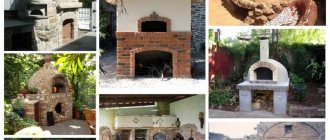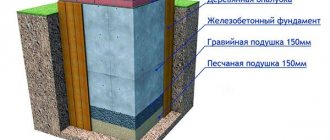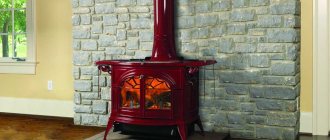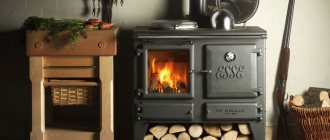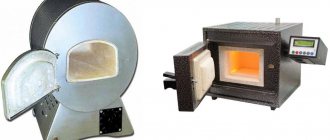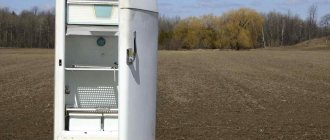The idea underlying the bell furnace was developed and first implemented by the Russian professor, founder of the national school of heating engineering, Vladimir Efimovich Grum-Grzhimailo. Currently, his work, in terms of improving the designs of existing brick kilns and creating new designs, is being worthily continued and developed by Igor Viktorovich Kuznetsov.
Do-it-yourself Kuznetsov stove: arrangement drawings and description of the stove laying
Since 1962, I.V. Kuznetsov has been designing, manufacturing and improving furnaces.
During this time, more than 150 different designs were invented, each of which strived for an absolute efficiency indicator - 95% efficiency. In this article we will tell you how to make a Kuznetsov stove with your own hands. Photo 1 Kuznetsov stove
The fundamental feature of the development is the system for separating gases into cold and hot flows. Due to the unique bell-shaped structure of the stove, hot air is retained inside, and cold air is discharged through a separate channel into the chimney pipe. Considering that a higher combustion temperature is maintained in the bell, and the heat is distributed evenly throughout the body, the efficiency reaches its peak. For comparison, the efficiency of conventional stoves is 30-35%, solid fuel boilers - 80%, pyrolysis boilers - 85%.
The low performance of most solid fuel units is explained by the fact that warm air exits along with combustion products into the chimney. In addition to the fact that the remaining volume is not always enough for full heating, quickly escaping flue gases further reduce the thermal threshold. In some designs, they try to solve this problem by increasing (lengthening) the chimney pipe, but then there is a risk of reducing draft and, as a consequence, reducing efficiency. The creation of such a unit that would provide full traction and increase heat transfer became the main goal of designer Kuznetsov.
Video 1 Construction of a heating furnace using the Kuznetsov system
Furnace shielding
During operation, the body of the metal furnace becomes very hot. This is extremely undesirable for residential premises, since the person in the room, facing the heating device, will feel very hot heat in the face, while his back may be cold. In addition, there is a high probability of a person getting burned.
To heat a room more efficiently, the infrared radiation emanating from a metal stove should be converted into a convection flow of warm air. How to do it? Very simple. The body of a metal furnace must be surrounded on all sides by a metal screen. The metal screen is placed at a distance of 7-10 mm from the furnace body and raised above the floor surface at the same distance.
When calculating the screen, it is very important to take into account the viscosity and heat capacity of the air present in the room. The distance between the oven and the screen should lead to the emergence of effective convection currents, allowing the screen to cool and distribute heat throughout the entire volume of the room. A properly designed screen will allow you to create convection, the heat transfer of which will be about 85% of the thermal power of the heating device.
The most effective screen form will be a combination of 2 L-shaped metal halves that can be moved apart from the furnace body. This design allows you to adjust the size of the gap between the walls of the screen and the heating device depending on the intensity of fuel combustion in the firebox. To ensure easy access to the door and ash pan, the front part of the oven is not shielded. Brick, sand or broken brick are used to shield the space under the stove. Shielding the space under the bottom of the furnace is one of the most important conditions for ensuring fire safety.
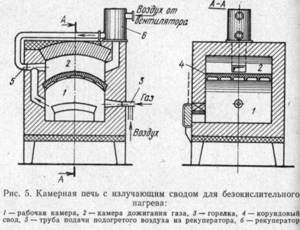
Shielding of sauna stoves
As you know, sauna stoves are designed to create higher temperatures compared to their room counterparts, so they have 3-5 times more power. Since the walls in the baths are predominantly made of wood, which has low thermal conductivity, the only way to effectively warm the air in the room is convection. To generate convection air flows, the sauna stove is equipped with a brick screen. A similar screen is constructed using sand-cement mortar; the masonry is made in half a brick.
Shielding stoves for a garden house
Most often, garden houses do not have a significant volume of interior space, so there is no need to heat them intensively. At the same time, to prevent the stove from becoming a source of burns to its inhabitants, the device must be shielded. It is recommended to use a metal structure as a screen for a garden house, which will serve as a container for heating water. The advantages of this approach are obvious - the stove effectively heats the interior, and the metal screen around it heats water for domestic needs.
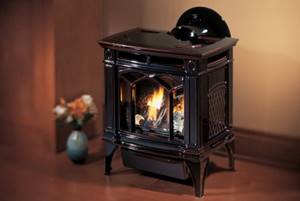
Heater furnaces
Convector ovens became a continuation of attempts to improve the convector screen. Heaters are designed in such a way that a significant part of the thermal energy they generate is distributed throughout the volume of the heated room by air masses of heated air. For this purpose, the convector is either mounted into the screen of a heating device or placed directly into its firebox.
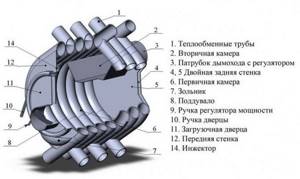
The most famous convector oven is the buller or buleryan oven. Buleryan is a long-burning stove using wood as the main fuel. It should be noted that the creators of the buller did a great job; they created a reliable heating device, the power of which can be adjusted over a fairly wide range.
A pipe-based convector is built into the round-shaped firebox, providing powerful convection currents in the room. The temperature of the furnace body and the temperature of the heated air coming from the convector does not exceed 70°C.
One load of fuel allows the buller to generate thermal energy for 8-12 hours. The efficiency of Buleryan reaches 60%. If the buller is surrounded by a screen, the efficiency can be increased to 66-67%. In this case, the screen will not heat up above a temperature of 55°C. Inside such a furnace, the temperature does not exceed 600°C, so you can use ordinary grades of steel to make it yourself.
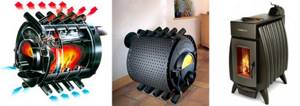
The high efficiency of the buller is due to precise calculations during its design. The balance of heat and air is very precisely maintained in the buller. If a home master is not a specialist in the field of heating engineering, it is unlikely that he will be able to independently calculate the necessary parameters of a heating device when trying to manufacture it himself.
As a rule, bullers are used for heating industrial premises in which it is necessary to maintain uniform heating throughout the entire volume of the heated room. The category of such premises includes greenhouses, greenhouses, animal nurseries, etc.
Air heating
Air heating can show its best qualities only in low-rise buildings. It has been experimentally proven that a higher number of floors in a building reduces the efficiency of air heating. In such a situation, for home craftsmen living in one- and two-story private houses, there are many opportunities to experiment and implement their most daring creative developments.
Slow burning homemade products
As is known, the design of a potbelly stove and similar stoves does not contain components, the careless or rough manufacture of which will lead to unsatisfactory operation of the device in the future. Everything is simple here. But when trying to make a buller with your own hands, you need to avoid mistakes, since any of them will make the stove either ineffective or dangerous to use. Let's take a closer look at the design of slow-burning furnaces. The figure below shows sketches of two of the most popular stoves and one promising design.

In position “A” a stove called “bubafonya” is displayed. This design is a copy of the Latvian-made Stropuva boiler. “Bubafonya” is a furnace with a closed smoldering zone, which makes it possible to achieve an efficiency value of about 70%, and when using a gas jacket, increase this figure to 75%. A high efficiency value was achieved as a result of additional combustion of pyrolysis gases under pressure located in the center of the combustion zone. When trying to independently manufacture a furnace of a similar design, bending should be done either from special steel or from steel with a thickness of at least 8-12 mm.
Wood shavings, sawdust, and dry small flammable debris can be used as fuel for “bubafoni”. Using coal or wood to fire a stove reduces the efficiency of the stove. The power of the heating device is 0.3 kW when burning 1 dm³ of fuel. In order to burn high-quality high-energy fuel in the Bubafoni firebox, its design must be redesigned. In particular, those located in should be equipped with profiled curved blades. This improvement will allow the stove to be reloaded with fuel during combustion without the risk of loss of combustion and the need for re-ignition.
Positions “B1” - “B3” display sketches of a popular open combustion stove called “Slobozhanka”. The design of this heating device is very simple. The functionality of the stove is absolutely not affected by its size. The stove works with wood and coal, as well as with any flammable waste. The stove has good performance characteristics, however, “Slobozhanka” is not able to compete with the “bubafon” due to the following circumstances:
- It is not only impossible, but also dangerous to reload fuel while the furnace is operating;
- open combustion does not allow achieving high thermal power, which is typical for furnaces with a closed combustion zone;
- The very rapid burning of the air distribution shaft housing during intensive operation of the furnace is due to the fact that ordinary metal 6 mm thick was used to create it.
To increase the service life and achieve greater specific power of the Slobozhanka, special steel should be used in the manufacture of its flame body. It is also necessary to make several air distributors in the walls of the housing (the layout is shown in position “B2”). In this case, it will be necessary to surround the structure with an air jacket with partitions, and make the blower ring (position “B3”). Industrial implementation of such modifications is associated with low profitability, and independent implementation in a home workshop is too complicated. For this reason, Slobozhanka stoves are produced by small manufacturing companies in very small batches. As a rule, stoves of this type are used in the southern regions for occasional heating of utility rooms.
In position “B” of the figure is displayed, which was mass-produced by the military industry of the Soviet Union. The device was intended for heating the barracks of small, remote garrisons. This heating device has high power. The stove, which has the size of a traditional fuel barrel, can effectively heat a room with an area of 150 m², with a ceiling height of about 4 m. A stove of this design can be heated with any fuel, from anthracite to household combustible waste. Fuel can be reloaded at any time.
Currently, this stove is not widely popular. Possible reasons for the lack of demand include the unattractive appearance and very large dimensions of the device. The standard configuration of this furnace included three additional sections consisting of two gas-air registers, each of which is a finned bundle of five two-inch pipes. Attempts to change the design of a chimney like the one typical for a potbelly stove did not lead to anything good. The hog became too hot, and uncontrolled gas emissions arose from under the lid.
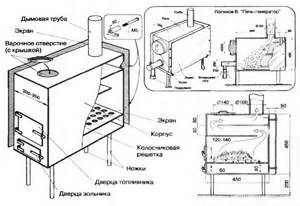
Construction of a Kuznetsov furnace with your own hands
The sequence of actions is as follows:
First, they study the floor plan of the room where the heating device is planned to be installed. In the case when the house is not built, it is necessary to ensure uniform heating of all rooms. It is not advisable to install a heating unit into a finished building, but if necessary, you can
But at the same time, you should take into account the location of the supporting structures and beams when arranging the chimney. Then the foundation for the heating device is prepared. It is made of concrete, and the width should be 10 centimeters greater than the size of the device
It is advisable to design the foundation for the stove at the house planning stage.
Kinds
According to their purpose and design features, blacksmiths can be divided into several types:
- Heating. The devices are designed for efficient and safe heating of premises.
- Cooking. Used for cooking. This includes ovens for baking bread and bakery products.
- Bathhouses. The Kuznetsov bathhouse stove is designed for simultaneous heating of the main bathhouse premises. Such devices have high heat transfer with minimal fuel consumption.
- Street. A stove complex consisting of a grill or barbecue for outdoor cooking.
- Fireplace. The equipment is used as a decorative element of the interior or as an additional heating option. Some fireplace stoves are equipped with special loungers for a pleasant leisure time.
The most popular are complex devices that are distinguished by their multitasking. A striking example is the Kuznetsov heating and cooking stove, which is intended both for heating residential premises and for preparing food.
Despite their functional features, all stoves operate on the same principle - effective distribution of heated gases in the bell into separate streams.
It is noteworthy that stove hoods can be equipped with additional equipment - electric heaters, hot water tanks, steam generators, oven and stove.
A competently designed and constructed Kuznetsov sauna stove will provide reliable heating in all functional rooms: steam room, washing room, dressing room, rest room. In addition, it will allow you to quickly heat water, accumulate hot steam and purify the air.
Operating principle of Kuznetsov bell furnaces: ordering
The operating principle of Kuznetsov furnaces is not complicated. When building a furnace, it is necessary to carry out all work according to drawings, diagrams and, of course, use procedures.
All Kuznetsov bell furnaces operate on the principle of separating combustion products. This principle lies in the fact that the gas generated as a result of fuel combustion is divided into two streams: cold and hot. The movement of gases inside the furnace design is very well thought out. Hot air is retained in the oven and retains heat for a long time. Cold air quickly flies into the chimney through a specially made recess. A furnace operating on this principle is called a bell-type (dome) furnace. Inside such a furnace, the hearth is combined with its lower part and forms something like a hood. It then acts as a gas separator into two streams. The flow of hot air rises and is retained in the hood, thus concentrating heat.
Advantages of Kuznetsov stoves:
- Cost-effective;
- Long-term heat retention;
- Slight soot formation;
- No need for frequent cleaning;
- A choice of different shapes and designs is possible.
The high efficiency rate (95%) of Kuznetsov furnaces is the result of a fundamentally new development and design features. For comparison, a traditional Russian stove has an efficiency of 25-40%. If Kuznetsov stoves have disadvantages, then they are few, and they are lost against the background of their advantages.
Operating principle of the furnace
We keep the house warm according to the weather; it is convenient to heat the stove in the evening for 2-3 hours. Each stack of firewood - 3-5 logs 33 cm long is limited by the dimensions of the firebox in plan - 38x38 cm. With each firebox we burn 12-17 logs, per season 4 cubic meters, taking into account the bathhouse and waste incinerator.
The main part of the heat is accumulated in the hood, which allows you to dry wet towels and wet clothes around the clock. The reversible sleeve allows you to warm your back and quickly relieve fatigue. The stove works as follows: combustion products (smoke) make 4 turns:
The pattern of movement (turns) of smoke is marked with numbers in circles.
1st turn - at an angle of 90 degrees from the firebox to the hood; 2nd turn - in the hood the smoke is divided into two streams and each goes around an angle of 180 degrees along the arc of the hood; 3rd - at an angle of 90 degrees - the right flow of smoke from the hood falls into the transfer sleeve (short path), and the left flow, having passed under the hood (long path), also ends up in the transfer sleeve; the 4th - at an angle of 90 degrees from the transfer sleeve into the pipe.
The movement of smoke in each element of the stove is different, and this is especially evident in the reversible sleeve, in its chimney, which in area (25x25 cm) is twice the size of the previous chimney of the hood. Once in the transfer hose, the smoke “rests” there - its pressure, speed, temperature drop and it is in no hurry to enter the pipe - to make the last turn.
Therefore, there is a springboard in the reversible sleeve, but that’s not all. The stable draft of the pipe is created by its heated base and the walls of the chimney. When finishing heating the pipe, leave hot coals at its base and close the door of the mini-fireplace. Now (after a long period of inactivity) you can light the stove.
The high efficiency of the stove is due to the chimney system located in the hood. The chimneys of the hood are heated on both sides, so they heat up more than the outer masonry of the hood. When the oven cools down, the hood retains heat longer than other elements, because heated from the inside by brickwork of internal chimneys. For such a benefit, as for a bed, payment is due in the form of the space occupied on the floor.
The bell-type stove occupies 16% of the room area (18 sq.m.).
The ash pan of the stove, thanks to its large height (25 cm), allows you to remove ash 1-2 times during the month; its volume (8 liters) is convenient to accumulate or immediately fertilize trees and shrubs.
When the stove returns to normal operation, the smoke from the chimney is not visible at all or is barely noticeable. Sometimes, to warm up the room a little, we only use a micro-fireplace.
During the period of operation (14 seasons), the following points in the kindling were identified:
- the most reliable thing is to split a dry aspen log a year or more old into twigs;
- If there is no dry firewood, we do the same with wet firewood and in the morning we put it in a well into a heated oven. During the day the firebox will dry out the contents, in the evening there will be kindling from one match;
- Birch bark is better suited than newspaper for burning wood - the top thin layer of wood, even wet birch;
- Chips of dry aspen are ideal for quick kindling, because it’s not for nothing that matches are made from it.
Recommendations for self-construction
If you decide to build a stove according to one of Kuznetsov’s plans with your own hands, get ready for careful and scrupulous work. On the diagrams you will find a graphic representation of each row, but before starting laying you need to become familiar with the features of the technique, in particular:
- selection and pre-processing of bricks;
- purchase of metal parts (plates, dampers, doors, valves);
- determining the most suitable location;
- preparation of the base and foundation;
- possibility of installing a chimney, etc.
Fireclay refractory brick (Sh-5, ShB-8) is recognized as the best material for the internal masonry of “smiths”, and ceramics (M-150) for external decoration. To strengthen brick walls, metal elements (rebar, wire) are used. In order for the stove to function with maximum heat output, experienced craftsmen hone not only their skills, but also every brick - literally. They polish every detail, which is why projects completed by professionals look flawless.
Fireclay brick masonry
Having the author's order in hand, we recommend not to experiment, but to follow the designated order. Deviations from the diagram do not guarantee complete heat transfer.
Bricklaying
In a classic stove, the heating firebox is located at the bottom, so the structure warms up more efficiently. In addition, such a device leaves virtually no soot behind. To build a bell furnace with your own hands you will need:
- solid and fireclay bricks;
- grate;
- steel plate;
- drill with attachments;
- a mixture of clay and manure.
See also: how to make mortar for bricklaying.
Brick laying is done on an absolutely clean foundation. Therefore, it is worth cleaning the floor in advance, and then laying heat-reflecting foil on it, which allows you to reflect the flow of heat that is directed downward, in which case the stove is protected from heat loss. The prepared foil should be slightly wider than the base. Once the design is ready, the edges of the paper can be cut off.
All further actions are carried out strictly according to the following scheme:
- In the first row, the brick is laid evenly; it is better to build the side walls using a spoon method, that is, move from right to left. As a result, there should be four bricks on the back and front sides, only two on the right, and three on the left.
- At the next level, a blower and a window are installed through which the single-bell stove can be cleaned. It should be noted that the window can be installed anywhere, the only condition is that it must be below the combustion chamber. The next row is laid similarly to this one.
- At this stage, it is necessary to reduce the hole where the combustion waste will fall. Its width should be approximately half a brick. They also make a partition that leads to the upper compartment; it should be located in the far corner from the firebox-oven.
- Work continues, but the edges of the discharge connector must be trimmed with fireclay bricks, and a grate must be installed on top. The next row is laid according to the same pattern.
- In the seventh row, you need to remove a chimney from the combustion pipe, the width of which is ½ brick, and it must go into the adjacent air compartment. The next level is laid out in the same way.
- Now you need to cover the firebox with solid brick, but the inside is lined with fireclay. In the 10th and 11th rows everything remains unchanged.
- At this level you need to lay out the sheathing, for this you need to take a fire-resistant brick, the masonry is carried out in ½ unit. The 13th row is laid according to the same pattern.
- At the next level, the movement of smoke is blocked using a steel plate, but bricks are used for the crossbar of the smoke collector. As a result, a single channel should be formed, which remained in the 4th row during laying.
The first level is considered complete, now you can begin the final work. This Kolpakov stove consists of 30 rows, although there can be fewer or more of them, the main thing is to maintain the order.
What is the difference
The main feature of the group of stoves invented by Kuznetsov is the absence of extended smoke channels with many turns and bends. To make the most of the heat from burning fuel, duct stoves have a system of passages through which hot smoke heats the bricks. In this case, the oven heats up unevenly at different levels, which can lead to cracking of the masonry. In addition, there is a need for regular cleaning of narrow places and corners.
Kuznetsov's stoves for home and bathhouses do not have this drawback. In them, hot gases from the firebox enter the so-called hood - an internal space limited at the top by the ceiling and having an outlet at the bottom. The heated smoke rises to the very top of the hood, where it lingers until it begins to cool. As they cool, they gradually fall down along the walls of the bell, and a new portion of smoke takes their place.
The cooled smoke exits through the channel into the chimney or into another hood, depending on the design and purpose of the stove. Gradually, as it passes through cascades of hoods, the flue gases cool to a temperature of 120-150 degrees. The temperature of the gases at one level of each cap is the same, which avoids uneven expansion of the brick.
Preparatory work
Before starting construction, select a location and determine the design and location of the chimney (both indoors and on the roof). After this, you can begin work on arranging the base of the furnace. If the heating unit is being built together with the house, then a common foundation is poured. In the case when the stove is placed in a living room, it is necessary to remove the part of the floor that falls on the “blacksmithing”. In this case, the outer contour of the stove base should be 10–15 cm larger than its dimensions.
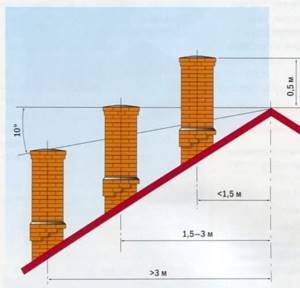
Options for placing a chimney for a bell-type stove
To arrange the foundation, make a depression of 20–25 cm, at the bottom of which a sand cushion 10 cm thick is poured, which is spilled with water and compacted. After this, a reinforcing mesh is laid at a height of 5 cm, formwork is installed along the outer perimeter and the structure is filled with concrete. You can start laying immediately after it has completely set, which, depending on the temperature, occurs in about 2–3 days.
In addition to pouring the base, you will need to prepare a solution before starting masonry. To do this, take clean clay and sifted river sand. The clay is poured into a large metal container, kneaded and soaked in a small amount of water. After it has liquefied well, add sand and bring the consistency of the solution to the state of very thick sour cream. Most often, stove makers use a proportion of 3 parts clay to 1 part sand, but the correct ratio of components depends on the type of clay - the higher its fat content, the more sand will need to be added (up to a 2:1 ratio).
When starting work, it is better to print out the orders on paper, crossing out each laid row during the construction process. Particular attention is paid to the installation locations of the lining layer - on the diagrams they are highlighted with a dotted line or a different color. Please note that if ordinary brick is used instead of refractory material, then such a stove will not only be short-lived, but also ineffective.
Design and operating principle
Bell furnace design
The stove with a hood was developed by engineer Igor Kuznetsov in the early 60s of the last century. Subsequently, Russian metallurgist Leonid Kotlyar improved the design so that it retains heat for up to 19 hours. The peculiarity of the “blacksmith” is that the heated air does not leave the pipe, but is collected under a hood. Slowly it cools down and is forced out by rising hot streams. Saving heat is the advantageous difference between a bell-type stove used for heating a house and a channel stove, where hot air, under the influence of draft, freely escapes to the street.
A two-meter-high structure with a base of 1m*1m can reach a thermal power of 3.5–4.5 kW. Such a bell-type stove is enough to heat a house of 50 square meters in a temperate climate zone, if you heat it twice a day.
The inventor improved the design by adding another cap. In Kuznetsov’s two-bell heating stove, the first covering element is connected to the combustion compartment and separates the cold and heated flows. The second cap is located in the upper part of the stove, trapping hot air, which, before entering the chimney, gives off heat to the bricks for a long time.
A two-bell stove uses fuel more economically and is usually equipped with a hob. This allows you to cook delicious meals without consuming electricity or gas. The design of the stove already includes an exhaust hood - there is no need to install an additional ventilation system.
Design Features
Kuznetsov furnaces are bell-type structures. They differ from traditional Russian stove models in that hoods are installed inside them. There may be several of them, and they may be arranged in different orders. But in any case, there is a space between them through which gases can move freely.
How it works
The method of constructing furnaces developed by Kuznetsov became an innovation in the construction industry. The fact is that in traditional furnace designs, heating occurred through draft in the channels. This led to uneven heat distribution in the furnace and the appearance of cracks in its walls.
In Kuznetsov models, gases move freely. Since the structures consist of caps located at a distance of 2–3 cm from each other, uniform heat distribution is guaranteed. The first hood is combined with the firebox. For this reason, the hottest gases rise to the top. They stay at the top of the structure for some time. By the time they cool down and descend, the walls of the furnace are already heated by them.
Then the process is repeated. This results in continuous and intense heating of the structure, and, accordingly, the room. But since one cap is not enough for optimal heating, most Kuznetsov models are equipped with two or three arches. The principle of operation in them is similar to the single-bell version.
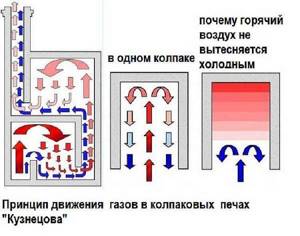
Advantages and disadvantages
Uniform heat distribution should be considered the main advantage of these structures. However, the advantages of using Kuznetsov models do not end there. The undoubted advantages of bell-type furnaces include the following factors.
- The efficiency factor is 95% (for comparison: in traditional Russian stoves it is 25%).
- More space for installing a steel heating element.
- No soot or smoke is emitted during the heating process.
- Kuznetsov furnaces should be cleaned many times less often than traditional designs.
- The construction of these models will be much cheaper financially than the construction of a Russian stove.
- Kuznetsov’s structures are durable and resistant to cracking.
- Such furnaces can be built to individual sizes and shapes.
- Kuznetsov’s models are distinguished by an aesthetic appearance, which can also be modified using imagination and various design solutions.
Apparently, due to all the above qualities, these designs gained popularity back in the 60s. And then they only improved and today they are practically free of shortcomings. Moreover, later Kuznetsov worked on developments not alone, but with a group of like-minded people.
Types of Kuznetsov furnaces
The variety of bell-type furnaces that exists today can be classified according to various factors. Thus, depending on the number of caps, the models developed by Kuznetsov are divided into single-bell, double-bell and multi-bell.
https://vk.com/video_ext.php
Based on their purpose, these models are divided as follows:
| Varieties | Application |
| Cooking type models. | They are designed for cooking. |
| Heating stoves. | Their primary function is to heat the room. |
| Sauna stoves. | Specially designed for rooms with high humidity. |
| Street models. | It can be either a barbecue or the most complex complexes. |
| Bread ovens. | These models are often combined with a cooking type. |
| Fireplace designs. | They perform, first of all, an aesthetic function in the interior of the room. |
In addition, there are also special-purpose furnaces, also developed by Kuznetsov.
Double bell oven
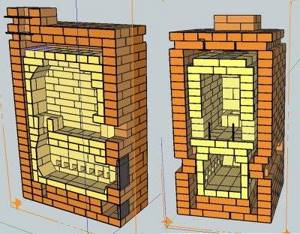
The most common option for high-quality heating of a private home is the Kuznetsov device with two hoods.
Its efficiency is significantly higher due to longer retention of hot air.
The heat-resistant brick hoods are located one above the other with a slight offset - the air displaced from the first hood immediately enters the second, from which it goes into the exhaust pipe.
The size of such a stove is directly dependent on the area of the house; it is even possible to build with an internal volume of up to 5 cubic meters. m. The firebox usually occupies the entire base area, this helps to increase the heating power of the air in the furnace.
d79996939d6d9526a6f20a7cb2b08264.jpe

18ae580d3f50fc0040ae71d956f18099.jpe
Reference. In the design of a two-bell furnace, special valves are often installed to insulate the second bell and reduce the heat transfer of the device. This is necessary in warmer times of the year, when high heating power is no longer required.
When using dampers, hot air from the first hood is directed directly into the chimney.
Steel furnaces
The most popular material for the manufacture of metal furnaces is ordinary steel. This material can easily withstand stable temperatures of up to 400 degrees, and during short-term kindling this value can reach 600 degrees. The thickness of steel usually starts from 4 mm, but one must take into account the high rate of metal burning at high temperatures - i.e. For cold regions this option is not practical.
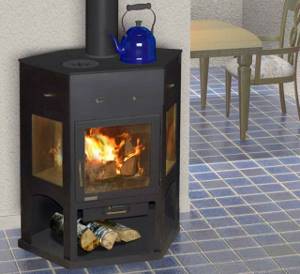
However, there are long-burning stoves, the body of which is simply not subjected to prolonged high-temperature heating. At the same time, heat transfer is maintained at the proper level due to heat accumulators made of more durable materials. Such an iron wood-burning stove is quite suitable for heating large houses located in regions with a harsh climate.
Kuznetsov's fireplace stove: ordering
Kuznetsov's fireplace stove is a large heat storage device. A brick structure that looks like a fireplace and is as warm as a stove. Due to its mass, the fireplace stove heats the room in a unique way.
The construction of fireplace stoves is a complex matter, but if you wish, you can do everything yourself. To begin such a complex process, you must have the procedures at hand. Kuznetsov's fireplace stove has a lot of advantages.
Advantages of fireplace stoves:
- The beauty and grace of stonework;
- Efficiency of brick heater;
- Low carbon monoxide and soot emissions;
- Long-term maintenance of a comfortable temperature in the house;
- Economical.
Some fireplace lovers make them look like works of art by decorating them with grates and decorative elements, using the services of a blacksmith. You can feel a pleasant feeling of radiant heat if you equip your country house or cottage with such a fireplace stove.
Advantages of dome stoves
This principle is used in many furnaces for various purposes. There can be several caps, they can have a symmetrical or asymmetrical structure, located side by side (horizontally) or one above the other (this option is often used to save space). This feature makes it possible to design stoves of any type and configuration, for any room and conditions. At the same time, the characteristics remain high: efficiency above 80% is almost the norm for Kuznetsov dome stoves.
Any device can be installed in the second hood: hob, heat exchanger, heater, hot water tank, bread oven, etc. There are many modifications and they all have one thing in common: high efficiency, economy, uniform heating. Moreover, when the caps are positioned vertically, the bottom heats up more intensely than the top. So it’s comfortable to be in a room with such a stove.
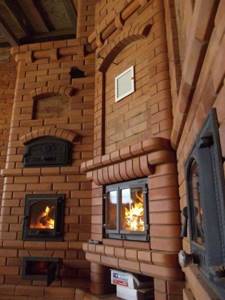
Some Kuznetsov stoves look more like works of art
It should be noted that much less brick is required to build such a furnace: more empty space inside. Therefore, the oven warms up faster. But, characteristically, it does not cool down faster. Everything happens exactly the other way around: Kuznetsov’s dome stoves produce much smaller daily temperature fluctuations than more massive analogues with a large number of channels. And all because the hottest part of the gases remains in the hoods, and the coldest part settles down and is removed from the furnace. Thus, the oven cools down more slowly.
Because there are no or almost no narrow ducts, a bell-type stove has less resistance to air flow, so the chimneys are shorter. Therefore, it is easier to build, and the foundation is not so massive, although it is definitely needed.
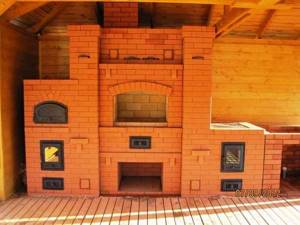
Furnace complex built on the principle of bell furnaces
After kindling and reaching operating mode, there is no need to regulate the operation of the stove with free movement of gases. The process turns out to be self-regulating. If the fuel flares up very strongly, the amount of hot gases at the top increases and squeezes colder ones into the second bell. And the colder ones include air coming from the blower. If there is a lack of air, the flame goes out, there are fewer hot gases, they rise higher and more air enters from below. The combustion is reactivated. Therefore, although there are valves in Kuznetsov’s two-bell furnaces, they are used extremely rarely, mainly for non-standard modes.

Another furnace complex
Automatic regulation of the combustion process leads to almost complete combustion of any fuel. That is, such a stove is omnivorous and not particularly demanding on fuel conditions. When using wet fuel, it takes longer for it to reach normal mode, but then the process stabilizes and the resulting soot burns out. This, by the way, is another advantage of dome stoves: they need to be cleaned very rarely, since there is little ash left and the soot burns.
Building a foundation for a furnace: universal instructions
Regardless of the stove model, it needs a reliable and durable base. This foundation is suitable for both the Swede and the two-bell model.
The sequence of arranging the support is as follows.
We dig a pit about half a meter deep.
Foundation pit
Second step
We compact the bottom of the hole and fill it with a 15-20 cm layer of sand. Pour water over the sand and compact it thoroughly.
Fifth step
We prepare a solution from part cement, five parts crushed stone, three parts sifted river sand and water. Fill approximately half of the free horizontal space of the pit with this solution. Let the fill dry.
Sixth step
We prepare a solution from part cement and three parts sand. Fill the remaining space of the pit with the mixture. Carefully level the upper part of the fill using a rule.
Poured foundation for laying a brick stove
Necessary materials
Before starting construction, you need to buy all the required materials and prepare the necessary tools in order to stop construction.
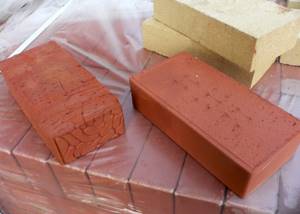
Fire brick
Materials for the construction of the furnace:
- refractory brick - for the construction of a firebox;
- fireproof mastic – for the firebox;
- ceramic brick (grade minimum m150);
- cement, sand and clay - to create the base and brickwork;
- wooden material - for formwork;
- wooden blocks 50x50 - installed in the corners for even masonry;
- metal corners, fittings, wire, plates;
- special foil for the base;
Tools for the construction of “Kuznetsovka”:
- drill with a whisk for mixing the solution;
- shovel and bayonet;
- Master OK;
- large or small grinder;
- large building level;
- roulette;
- bushhammer;
- container for solution;
- saw (hand or electric saw).
This is what the minimum set of tools will look like, without which it will not be possible to achieve the desired result.
Types of designs with an oven
Kuznetsov furnace
It is installed in rooms with minimal space possibilities, while the design and decoration are selected individually. A special feature of this type of furnace system is its high efficiency, which for such devices is more than 80% along with a small amount of soot formed during operation. The design is suitable for placement in any area of the room; it is possible to place several similar stoves at once. Any type of solid fuel is suitable for the firebox.
Bykov's device
The thick-walled structure has a simple laying pattern and a rectangular shape. This type of stove provides for placing the device in 2 rooms at the same time. Nevertheless, the Bykov design has significant differences in its structure from bell-type structures. The lower region includes 2 gas channels: ascending and descending. The upper part has the shape of a sieve, the cap of which is divided by 5 channels.
Metal for the furnace
It is easy to see that the physical and chemical characteristics of the metal used to create the furnace have a direct impact on the quality of operation and service life of the heating device. Therefore, when purchasing or making a stove yourself, you should pay the most serious attention to the quality of the metal. Let's look at the characteristics of the metals most often used to make stoves.
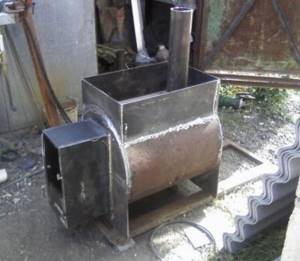
Aluminum and its alloys
On the pages of the World Wide Web you can often find descriptions of the process of manufacturing metal ovens based on such an unusual starting material, which is an aluminum milk can. Perhaps the volume of the container allows you to create a metal furnace from it, but we should not forget that aluminum has a low melting point compared to steel. Aluminum melts at a temperature of 660°C. To burn wood-based fuel, a temperature of at least 400°C is required. To ensure that combustion products do not contain carbon monoxide, which is dangerous to human life, the temperature in the boiler furnace should not be lower than 600°C. I think that all subsequent explanations are unnecessary.
Ordinary steel
The temperature limit of ordinary steel does not exceed 400°C. As a rule, a steel sheet with a thickness of at least 4 mm is used to make the furnace. It is possible that in a temperate climate, subject to infrequent use, a stove based on this type of steel will last for several years. However, ordinary steel is absolutely unsuitable for creating furnaces, which, due to operating conditions, must be heated daily. In this case, it will be very good if the heating device lasts at least until the end of the heating season.
Heat-resistant varieties of steel
Modern industry manufactures furnaces using heat-resistant steel with a thickness of 1.5-3 mm. Such heating devices are distinguished by their low dead weight and long service life - 20 years or more. Industrial furnaces based on heat-resistant varieties of steel have high efficiency, the numerical value of which exceeds 80%.
Factory-made stoves go on sale with a certificate from the Ministry of Emergency Situations, confirming the high fire safety of the device. Industrial-made metal stoves are easy to install; all the user needs is to install the device in the chosen location and connect the chimney to it.
Cast iron
According to its physical characteristics, cast iron differs from steel. Cast iron is fragile, its thermal conductivity is not as high as steel, but the heat capacity of cast iron is much higher than steel. A cast iron-based stove continues to heat the room after 3 hours after the fuel has finished burning.
For the manufacture of metal stoves, cast iron with a thickness of 6 to 25 mm is used. Cast iron stoves have a very decent dead weight. As a rule, cast iron stoves are used to heat small rooms. The low thermal conductivity of cast iron does not allow the use of stoves based on it in large rooms.
Cast iron cannot “breathe”, however, its chemical resistance is close to that of ceramics. Cast iron stoves, unlike their steel counterparts, are not afraid of long breaks in operation. Most often, cast iron-based stoves are used to heat the premises of greenhouses, poultry houses, rabbit hutches, etc.
Second thermal load
Nothing works on bare principles. In order for a theoretically absolutely correct stove to heat, dry and cook well, it must also be made correctly in the material. In relation to bell-type furnaces (and especially double-bell furnaces), this means that the thermal load on the material must be high. Making a bell furnace massive, with thick walls, is like lighting a fire in a cave. To feel the warmth, you need to sit next to the fire, and there will be soot...
c309b8141378ec4433e1fa6a65105e41.jpe

eb9a96611664c70a0b926656370364e4.jpe
Take a look at fig. On it are drawings and orders of some Kuznetsov stoves: a bathhouse. heating and cooking. a double-circuit hot water boiler and an improved Russian stove with a stove bench. Not being an experienced stove maker, it is clear that the material per unit of output power (500 W * sq. m of outer surface) in the Kuznetsov stove uses one and a half to two times less than in traditional ones. In general, any bell-type oven is “emptier” inside than a channel oven of equal power.
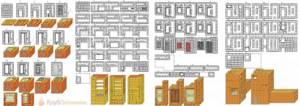
Orders of some Kuznetsov furnaces
On the one hand, this is good; bricks and mortar cost money. But on the other hand, it requires careful development and adherence to construction technology (see below). The heat load, which would not cause a pile of cobblestones to move, would destroy a thin brick wall even during the accelerating fire.
Structural mechanics are also important for Kuznetsov furnaces. The strength of the wall with clay mortar decreases much faster when its thickness decreases than with cement-sand mortar. Therefore, the foundation for these furnaces must be done especially carefully in strict accordance with the author’s recommendations. They must be strictly followed during construction.
Note: I.V. Kuznetsov allows freely copying his materials for himself, for construction, but objects to republications. However, the pictures in Fig. small. An amateur cannot build anything using them, but a master knows where to get full-fledged drawings. Therefore, we hope that Igor Viktorovich will forgive us this small borrowing for the benefit of the cause.
Features of masonry: materials and recommendations
It is recommended to use ordinary clay solid bricks for laying the body and chimney. Brand M150 and higher, size 250*120*65 mm. It is not difficult to calculate the amount of bricks for Kuznetsov stoves: you need to multiply the number of rows of the model you have chosen by 0.8. This amount is enough to lay the hull (taking into account the battle and rejection). For the chimney you need to count separately. The calculation scheme is slightly different: you know how many bricks are in one row, multiply by the number of rows (each is different depending on the dimensions of the stove and the height of the building), add 10% for the battle and get the required number.
For the fireclay core (if any), Sh-5 (230*114*40 mm) or ShB-8 (250*123*65 mm) is recommended. Its quantity is calculated individually according to the scheme. The core in Kuznetsov furnaces is not connected to the body, that is, there are no common points of contact between them. Between the two parallel walls, the body and the fireclay core, there should be a gap of 5-6 mm. To make it easier to withstand, you can wrap the finished core (usually it is placed first) with ordinary packaging cardboard of the appropriate thickness. Instead, for better thermal insulation of the firebox, you can lay a heat insulator, basalt cardboard, for example.
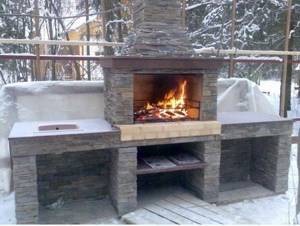
Barbecues can also be built according to the principle of bell-type stoves
The height of the rows of ceramic bricks does not coincide with the height of the rows of fireclay. They do not need to be adjusted one after the other. It is important to maintain verticality and horizontality, monitor angles, as well as the recommended seam width. And then everything will be as it should be. In reality, the dimensions of ceramic bricks differ from the standard 250*120*65 mm. If the deviations are not critical, they can be corrected with a seam. Therefore, when calculating stoves and their heights, they take the height of the brick with the seam. It should be 70 mm. But you cannot make a seam larger than 7 mm, so look for a brick of suitable quality and size.
At the top, in the places where the fireclay laying ends, there are compensation gaps that take into account the different expansion coefficients of the materials. It is imperative to observe them: the expansion of fireclay bricks is greater than that of ceramic bricks, and if there is no such gap, the core will after some time break the masonry on top due to the fact that it expands more strongly.
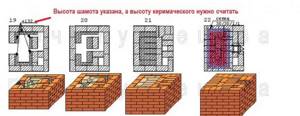
Cutting from the order of the Kuznetsov stove with a mark
The size of the gap must be calculated according to the marks in order. The height of the last row of fireclay is marked on the drawings. Calculate the height of the ceramic brick wall yourself: multiply the number of rows by the height of the row with the seam (70mm) and get the required value. It should be 10-15 mm greater than the height of the fireclay. This gap is compensatory and it must be present. The resulting void is filled with stone basalt wool (not glass wool, but one that has a use temperature above 1200°C).
If there are columns and internal walls inside (usually a quarter thick), the brick can be laid flat or on edge in them. There is no difference, do what is more convenient. There are places in the drawings where in one row there is a brick placed flat and on its edge. In this case, it needs to be adjusted to size (cut).
There are also nuances in the installation locations of furnace castings. Due to the specifics of the program, the drawings above the firebox door show ceramic bricks, but fireclay needs to be placed there on edge. When there is a difference in height, the voids are filled with cut fireclay plates. There remains a gap of 5 mm between the metal parts and the masonry - again due to different temperature expansions. A suitable heat insulator (with an operating temperature of 1200°C or more) is placed in this gap.

For thermal insulation of furnace castings, asbestos cord was previously used. Now they recommend basalt wool or cardboard
Now about the mortar: for laying the body (made of ceramic bricks), clay or clay-sand mortar is used. For laying fire-resistant fireclay, purchased compounds (fire-resistant mastics) are used. Kuznetsov does not recommend soaking the brick before laying it. If you need to do this, then only with secondary raw materials. Immediately after completion, the oven must be dried, even if you do not put it into operation immediately. If this is not done, then during the first few fires there will be a smell of fumes.
How to make Kuznetsov brick stoves with your own hands
IN AND. Kuznetsov developed a large number of furnace designs. Some types of stoves can be made with your own hands. To do this, you will need the order of the furnaces and their drawings.
Many, knowing about the positive reviews about Kuznetsov’s stoves, and also in order to save money, begin to build them themselves. Everything will work out, of course, but for this you need to use the appropriate materials and strictly follow the procedures.
Materials used for the construction of the Kuznetsov furnace:
- Fireclay brick;
- Clay brick brand M150;
- Good quality clay;
- Cleaned sand;
- Metal fittings.
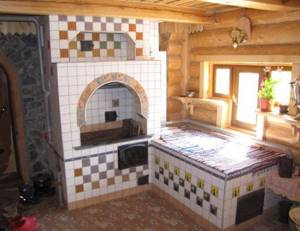
For the construction of internal masonry, fireclay bricks are used. According to the order, you can calculate its quantity. For the construction of external masonry, clay bricks are used, preferably grade M 150. Its quantity is also calculated using the same order. It is recommended to use only good quality clay for mortar. Purified sand for masonry is used twice as much as clay. You can use commercially available clay-sand mixtures. For 500 bricks you will need about 0.2 cubic meters. m of clay-sand mixture. In addition, you will need grate bars, two doors (blower and furnace), two steel corners and five meters of wire. Kuznetsov’s book “Building stoves and fireplaces: a practical guide” will help you build the structure you need. It presents all types and designs of stoves and fireplaces.
Types of furnaces
There are several types of stoves for heating greenhouses, differing in the following parameters:
- The principle of thermal radiation.
- The principle of heat distribution.
- Basic design elements.
- Type of fuel combustion chamber.
- Location and design of air supply channels.
- Convection shirts.
- Additional elements. As a rule, each type of oven has its own.
It is not difficult to make a stove for a greenhouse with your own hands. At the same time, a long-burning sawdust stove can effectively heat the air in a large greenhouse.
As fuel in greenhouse stoves, you can burn not only sawdust, but also the following types of fuel:
- Pellets.
- Peat granules.
- Regular firewood.
- Oil and other types of liquid fuel.
It is worth noting that the order of stoves for heating greenhouses of different sizes can vary significantly. Therefore, before starting work, it is recommended to carefully familiarize yourself with the theoretical material.
Gallery: long-burning bell-type stoves (25 photos)
Kuznetsov furnaces design and principles of operation, advantages, variations, drawings
Kuznetsov's stoves are well known not only to stove makers - they heat many homes in Russia and abroad. I.V. Kuznetsov has been working on improving furnaces since 1962 and has gathered around him a strong team of like-minded people. The team has more than one and a half hundred developments to its credit, covering almost the entire range of household stoves, see fig.

Some of the furnaces of I.V. Kuznetsov
Many would like to build one of Kuznetsov’s stoves with their own hands, and this article will help them. But we are not going to reveal some hidden secrets of the “blacksmiths” - they simply do not exist. On Igor Viktorovich’s website stove.ru, those interested will find a huge array of stove information for free: from information on the design and construction of stoves to detailed drawings and recommendations for installing a stove in a house and constructing a blind area around a building with stove heating. We also do not intend to criticize or correct anything in this home-stove encyclopedia: we are, to put it mildly, far from I.V. Kuznetsov in the oven business.
The purpose of this article is to provide a kind of introduction to Kuznetsov’s body of information, allowing one to more freely navigate the source material. Let us explain with an example why this is necessary.
Let's say I'm a generalist auto mechanic with extensive experience and want to pass it on to others who are interested. A car is a complicated thing. If I begin to get distracted along the way, explaining in detail that how running and caster (let’s assume that readers are not exactly dummies, now everyone drives) affect the handling and directional stability of the car, and the valve timing diagram affects fuel consumption depending on road conditions. conditions, and so on, I will eventually become confused to the point that I myself will no longer understand how the car I drive works. Willy-nilly, I will have to present the material, albeit “on the fingers,” but in a professional, fluent manner.
However, it will be a little difficult to read even for specialists like me, but for an amateur it will make his head spin. Therefore, I will need someone to help me, who can be called a “half-teapot”. In fact, he is not a kettle at all; he can adjust the suspension and set the valve lifters himself. But in this case, his task is to describe how the entire filling of the car is assembled into one whole, controlled according to the principle: “steer with the steering wheel, gas with the gas, brake with the brake.”
In the automotive industry of the USSR, a similar situation arose in the late 50s and early 60s, when the industry began producing cars for wide sale to the public. Then the super bestseller of that time, “How a Car Works,” was published. Edited by none other than the most important designer of the legendary “Victory”, A. A. Lipgart.
Information “from the recipient” will not yet allow you to start working: it does not provide deep knowledge that will allow you to at least intuitively estimate the required values of numerical parameters along the way. But it is essentially fundamental: mastering it, a professional text can be read with understanding and faster. And, if somewhere in it something is still unclear, it no longer causes loss and wandering, but simply a mark in the mind: this is what you need to find out in more detail.
The government has not yet adopted any landmark resolutions on stoves and stove heating. But their role in household heat and power engineering in times of energy shortage is undeniable: already a heating stove with an efficiency of 70%, when used on a large scale, will provide fuel savings on a national scale, because The designs of new heating plants include heat losses in the mains of 35%, and it is not yet possible to reduce them. So, with the popularization of stove knowledge, you have to figure it out yourself, without being either Lipgart or Kuznetsov. Well, let's try.
Furnace designs for private low-rise construction
About 150 bell furnace designs have already been created and brought to life. All of them have stood the test of time and are working successfully. Kuznetsov’s team of like-minded people continues to develop new options, improving existing ones. His website contains complete information with detailed descriptions and recommendations for making stoves.
Models are indexed and written with abbreviations. For example, OVIK stands for “heating and cooking stove by Igor Kuznetsov.” OIK is simply “heating”, etc. Each project is accompanied by step-by-step instructions and visual ordering, made in the AutoCAD program.
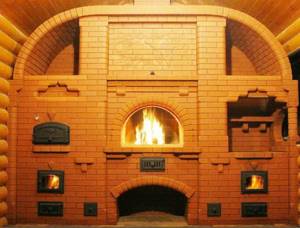
Combined model of a stove with a fireplace: the location of the fireplace on the stove is selected based on the layout of the room - a side fireplace, a back fireplace and a side fireplace with a stove bench
There is no need to do calculations and calculations: the site provides accurate measurements and descriptions of finished projects. If necessary, you can contact Kuznetsov and discuss the design conditions with the formulation of a specific task.

Vertically located hoods allow you to build a narrow stove if the room is very small.
The stove can be installed in any home: a new building or an already built one. But construction in a finished house will cost more, since the roof will have to be partially dismantled to remove the chimney. It is better to schedule work for warm weather. To choose the right place to install the stove, you should remember that the closer it is located to the center of the room, the more uniform the heating will be. At the same time, the stove is located closer to the front door - it is more convenient to bring in fuel.
Video: construction of a Kuznetsov furnace with a water boiler
A round-shaped dome stove operates with the greatest heat output. But if we are talking about a small room and the radius of the furnace circumference is less than 2 m, complications arise with the installation of furnace castings - firebox doors, cleaning pockets, etc. Metal parts designed for flat surfaces are not placed in semicircular shapes: gaps and cracks will appear, which is unacceptable.
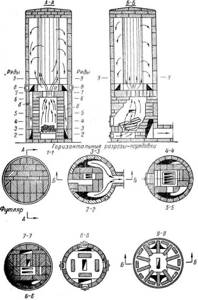
A schematic representation of the functioning of the furnace with horizontal cuts and orders helps to better understand the specifics of laying bricks
An experienced craftsman with an assistant lays out a bell-type stove in 2–3 weeks (depending on the complexity of the model). The process is unhurried and requires great care; the fitting of all parts must be careful, with measurements. A beginner will need more time, and you need to be prepared for this before starting work.
More about round ones
Round stoves theoretically have a lot of advantages, but they are not very convenient in the house. However, there is also a significant demand for compact mobile ovens, and here the extremely high efficiency of round multi-caps can be a decisive factor, because when the size of the oven decreases, its efficiency drops sharply due to the square-cube law.
Such furnaces, of course, would have to be made of metal. This solves the problem of cleaning; the stove can be made collapsible. But the choice of metals suitable for the ratio of heat capacity and thermal conductivity is extremely limited. The only inexpensive ones are cast iron, but it is heavy and fragile.
However, there is a lighter and stronger metal material with similar properties. These are products of powder metallurgy. In relation to scissor knives, “powdered crap” is quite justified, but for a stove in which nothing works for shear, powdered parts can be a godsend.
The second problem, which has already been mentioned, is the heat-resistant lining on the arch of the first cap. If it can be solved, then perhaps the works and efforts of Igor Viktorovich Kuznetsov will bear fruit that is more extensive and significant than it now seems.
Main manufacturers
Let's look at the most popular manufacturers on the modern metal furnace market.
Teplodar
Teplodar - model “Vertical” (increased long-burning mode gives 8 hours of heating without adding fuel), “Stove” is equipped with a hob with removable rings, “Top Model” and “Matrix” can act as a fireplace due to fireproof glass in the doors , from where the flame is visible. The T-80 model can be equipped with a smoke exhaust.
The stoves of this manufacturer are designed to heat houses with an area of 80-300 m3, and the cost is scattered within 10-25 thousand rubles.
Operating principle of ovens with two hoods
The secret to the efficiency of this stove lies in its original design, which allows it to accumulate and save heat for a long time. To understand the operating principle of a two-bell furnace, let’s consider its design diagram.
After kindling in winter, hot flue gases rise under the arch of the lower hood, transferring heat to the surrounding walls and hob. But new air enters the combustion chamber, the combustion process continues and the release of hot combustion products continues, displacing cooled gases under the top of the bell. Those, in turn, descend and fall into a vertical channel leading to the upper bell, where the two-bell design of the furnace provides for the repetition of the previous process with the release of gases out through the chimney.
The temperature of the exhaust flue gases is lower than any other stove with a stove, since they intensively transfer their heat to the walls of the stove. For this reason, chimneys of heat sources of this design must be protected from the destructive effects of condensation. After heating is completed, the heat remains for a long time at the top of both hoods, even if the main valve remains open. Cold air entering through the ashpit cannot rise under the hood arch and passes into the chimney along the path indicated in the diagram by blue arrows.
A two-bell cooking stove with a stove allows you to cook food in the summer thanks to an additional valve, the opening of which allows gases to pass directly into the chimney pipe. If the valve is not opened completely, then the flow of combustion products will be divided into two, going along different paths. In this way, in the autumn-spring period, you can regulate the intensity of heating of the hoods, that is, the thermal power of the stove.
How to choose a stove type and organize a heating scheme
What is a stove?
Before continuing further conversation about stoves, it is necessary to define the concept itself. So what is a stove? Despite the different definitions present in different sources of information, we will assume that a stove is a device designed to generate thermal energy and its subsequent transfer to consumers without the use of heat supply communications.
Domestic ovens
Domestic stoves are heating and cooking generators of thermal energy. The main schemes for converting fuel combustion energy into heat are shown in the figure.

Chamber furnaces
On the left in the picture you can see a chamber-type oven. Similar designs have been used by humans since ancient times. In a chamber-type furnace, the flue gases emanating from the furnace enter the gas chamber through natural circulation, where the process of their final combustion is completed. The air required for fuel combustion also enters the firebox naturally. Simply put, a chamber oven is a fire in a cave. An example of a chamber-type oven is the traditional Russian oven.
Channel furnaces
In a furnace with a channel design (middle image), the burnt flue gases, passing through the channels of the structure, give off heat to the walls of the furnace. The process of combustion of flue gases is possible only after the furnace body has warmed up to a temperature of 400°C, therefore it is impossible to achieve high efficiency values from a furnace of this type.
Bell furnace
The right image of the picture shows a bell furnace. In a device of this kind, flue gases are kept under the roof of the hood until they are completely burned. Subsequently, the cooling flue gases descend down the walls of the furnace, releasing the available heat. The bell furnace has an efficiency factor of about 70%.
Metal based furnaces
Since metal has high thermal conductivity and low heat capacity, it cannot be called an effective thermal energy storage device. Simply put, metal heats up very quickly and cools down just as quickly. However, building a competent design of a metal-based furnace will create conditions for faster heating of the firebox and combustion chamber of flue gases, which will increase the efficiency of the heating device. The figure shows schematic images of modern metal furnaces.

Chamber metal furnace
A metal chamber-type furnace is represented in the figure by position “A”. This is nothing more than the familiar potbelly stove. Metal chamber furnaces first appeared on the market at the beginning of the 19th century. In those distant times, fuel was very cheap, so no one paid any attention to the unusually high gluttony of this stove. After the revolution of 1917, there was a shortage of fuel resources in the country, which necessitated the need to make the chamber metal furnace more economical.
As a result of modifications, the furnace underwent the following changes:
- a grate with a door and a blower was built into the furnace body, which made it possible to regulate the power of the device depending on weather conditions;
- the chimney height was reduced to 2.5-3 m;
- the stove was equipped with a chimney whose diameter corresponded to the ratio: 7-9 mm/1 kW of the thermal power of the stove;
- a 1 m section of the chimney from the stove body was placed in a vertical position and covered with a layer of thermal insulation;
- Behind the vertical section, a horizontal part of the chimney, about 2.5 m long, was installed, which went out into the window vent of the room.
As a result of this modification, the efficiency of the chamber metal furnace was increased to 60%.
Channel metal furnace
Position “B” of the figure shows a channel metal furnace. As you can see, there is no flue labyrinth. Since metal has a high thermal conductivity, there is absolutely no benefit from the passage of flue gases through the labyrinth, therefore, in the design of this type of furnace, only one horizontally located elbow is left.
In comparison with a channel brick stove, its metal counterpart is characterized by the following advantages:
- High efficiency, the numerical value of which is 70-80%.
- The thermal power of the furnace in relation to the volume of the structure increased by 2-3 times.
- The stove is not critical to the parameters of the chimney and the amount of draft.
- The furnace operates in both continuous and flame combustion modes.
- The metal partition between the firebox and the afterburner, which has high thermal conductivity, almost instantly provides the temperature in the latter’s container that is necessary for the flash of unburned gases.
- The presence of separate air supply to the afterburning chamber and the firebox allows the stove to be operated with any type of solid fuel.
- The power of the generated thermal energy flow does not depend on the amount of fuel loaded, but on the air supply mode.
- Using high-quality coal or wood fuel will increase the frequency of chimney cleaning work up to 5 years.
long burning stoves
Metal furnaces with a bell-type design cannot operate in combustion mode. This is due to the fact that exposure to flame will quickly burn out the inner surface of the cap. Therefore, furnaces of this design operate exclusively in the smoldering mode of fuel material. As a result, it was possible to increase the heat transfer time of the heating device to 60-72 hours with one load of wood and up to 20-30 days with one load of coal. A schematic representation of a long-burning furnace is shown in position “B” of the figure.
The oven operates as follows. During smoldering, the loaded fuel undergoes pyrolysis (decomposition of the solid mass into flammable gaseous components). The gases obtained as a result of pyrolysis burn in the bell. At the same time, the efficiency of the furnace reaches 60%.
Any solid organic fuel can be used as fuel for long-burning furnaces. Long-burning stoves have high environmental characteristics, since as a result of their operation only carbon dioxide and water vapor are released into the atmosphere.
Oil-pyrolysis furnaces
Position “D” of the figure shows a schematic representation of the inside of the oil-pyrolysis furnace. This heater uses waste automobile oils as fuel.
The process of generating thermal energy begins with the slow burning of oil in the tank when primary air is supplied. During slow combustion, the oil evaporates, and its vapor enters the pyrolysis column, where it decomposes into lighter combustible fractions, the combustion of which releases thermal energy.
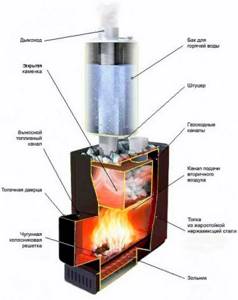
Features of the Kuznetsov furnace
Since the main goal of Kuznetsov’s developments was efficiency and productivity (he worked to increase the efficiency value), this required a fundamentally new and improved approach.
From the above, the conclusion follows: the system of free movement of gases created by this master is more natural, it optimizes the operation of the device and uniform heating. In addition, soot formation is minimized.
In addition to these advantages, Kuznetsov furnaces have other positive aspects:
- combustion occurs without soot and smoke;
- heating is more uniform;
- better heat transfer;
- the need for cleaning is ten times less;
- efficiency;
- there is more space to place the steel heating element;
- low level of heat loss;
- resistance to cracks;
- the ability to change the shape and design of the structure.
Construction of the Kuznetsov furnace
In most models that were invented earlier, hot gases always moved through channels. During their movement, the structure heated up and then cooled down. This movement of gases was created by draft. At the same time, the body was heated unevenly, which ultimately led to cracks. The heat exchanger was placed in the firebox because there was no more room for it. There it came into direct contact with fire and its service life quickly expired.
d929e2742175cf2fa25982de10eadaee.jpe
Kuznetsov used a completely different principle of gas movement for his model. The stove has hoods turned upside down. The caps can be mounted on top of each other and tied together with a dry seam, as a result of which gas begins to pass through them from one cap to another. It is because of this principle of operation that the Kuznetsov furnace is also called a bell furnace.
Improve your designs I.V. Kuznetsov started in 1962, and a large number of like-minded people gathered around him. Many summer residents also want to create a Kuznetsov stove with their own hands. Let’s say right away that you can build a Kuznetsov bell furnace with your own hands, but like-minded masters did not reveal many of the hidden secrets, or maybe they simply don’t exist.
It is worth noting that, thanks to the operating principle of the Kuznetsov stove, it is possible not only to create separate heating in the house, but also to obtain a supply of hot water. To do this, the rear side of the hood must be equipped with a steel heat exchanger.
Advantages of the Kuznetsov bell furnace:
- Smoke gases are stratified throughout the entire structure equally after the combustion chamber.
- One building may have not one, but several hoods. They will help achieve more warmth.
- The hood is located near the firebox and all carbon monoxides enter it. Therefore, ash, carbon monoxide and volatile hydrocarbons, which in other furnaces exit through the chimney, in this case burn out under the hood. This will increase heat transfer and minimize soot production.
- With the help of their convection, all products formed as a result of combustion cannot escape from the oven, so they give up their heat to it.
- The heat exchanger in this building is located in the hood or outside the combustion chamber, so it does not affect the temperature of the fire and cannot reduce efficiency.
Heat-resistant steel stoves for home
The next material from which metal furnaces can be made is heat-resistant steel. The minimum metal thickness in this case is 3 mm, which makes it possible to further reduce the weight of the structure. The efficiency of such devices often exceeds 80%, and the service life is 20 years. Metal stoves made of heat-resistant steel are safe, efficient and very easy to install - just install such a structure on the floor and connect it to the chimney.
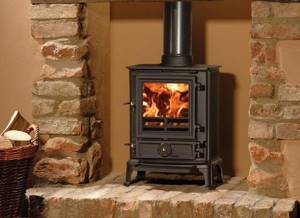
Optionally, heat-resistant stoves are equipped with a hob and a water heater, which allows them to be used both in the country and in houses with year-round use. Unlike steel stoves, devices made of heat-resistant steel have a complex design, so such an iron stove for a summer house cannot be created with your own hands - it will be much easier to purchase and install a ready-made device.


